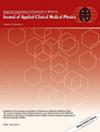The effect of interfractional variation on delivered dose with ultrahypofractionated pencil beam scanning proton therapy for localized prostate cancer
Abstract
Purpose/objectives
Proton stereotactic body radiotherapy (SBRT) using the pencil beam scanning (PBS) technique is increasingly used for localized prostate cancer (PCa) due to its potential for superior normal tissue sparing. However, interfractional anatomical variations pose challenges for accurate dose delivery, especially in ultrahypofractionation. This study investigates the dosimetric impact of these variations in PCa patients treated with PBS-SBRT.
Methods
Forty-two low- or intermediate-risk PCa patients treated with PBS-SBRT (36.25/ 40 Gy in 5 fractions) were included. Delivered doses were calculated by applying the initial plans to HU and artifact-corrected pre-treatment cone-beam computed tomography (CBCT) images. Dosimetric parameters were evaluated per fraction. Key anatomical features included clinical target volume (CTV) shifts in the superior-inferior (SI) and anterior-posterior (AP) directions, and volume changes in the bladder and rectum. These features were used to predict deviations in CTV D99 and D0.03cc, as well as maximum bladder and rectum doses. Univariate and multivariate logistic regression models were developed to identify significant anatomical predictors of dosimetric deviations, with odds ratios (OR) and area under the curve (AUC) values reported for predictive performance evaluation.
Results
CTV AP shifts and bladder/rectum volume changes were significant predictors of dosimetric deviations. Univariate analyses indicated that bladder volume increases > 109.80 cc were strongly associated with deviations in CTV D0.03cc (mean deviation = 0.33 Gy, OR = 5.78, p = 0.03). Rectum volume changes > 9.22 cc were the strongest predictor of rectum D0.03cc deviations (mean deviation = 0.68 Gy, OR = 4.23, p = 0.01). AP shifts > −0.27 cm were also predictive of CTV D0.03cc deviations (OR = 0.35, p = 0.01). Multivariate model predicting rectum D0.03cc achieved the highest AUC (0.73), followed by CTV D0.03cc (AUC = 0.68).
Conclusion
Multivariate models incorporating bladder volume changes and CTV shifts accurately predict dosimetric deviations in PBS-SBRT. These findings highlight the need for adaptive strategies during PBS-SBRT to mitigate the impact of interfractional variations, optimize dose delivery precision, and reduce toxicity in high-risk patients.




 求助内容:
求助内容: 应助结果提醒方式:
应助结果提醒方式:


